Enteral Feeding Devices Market Size
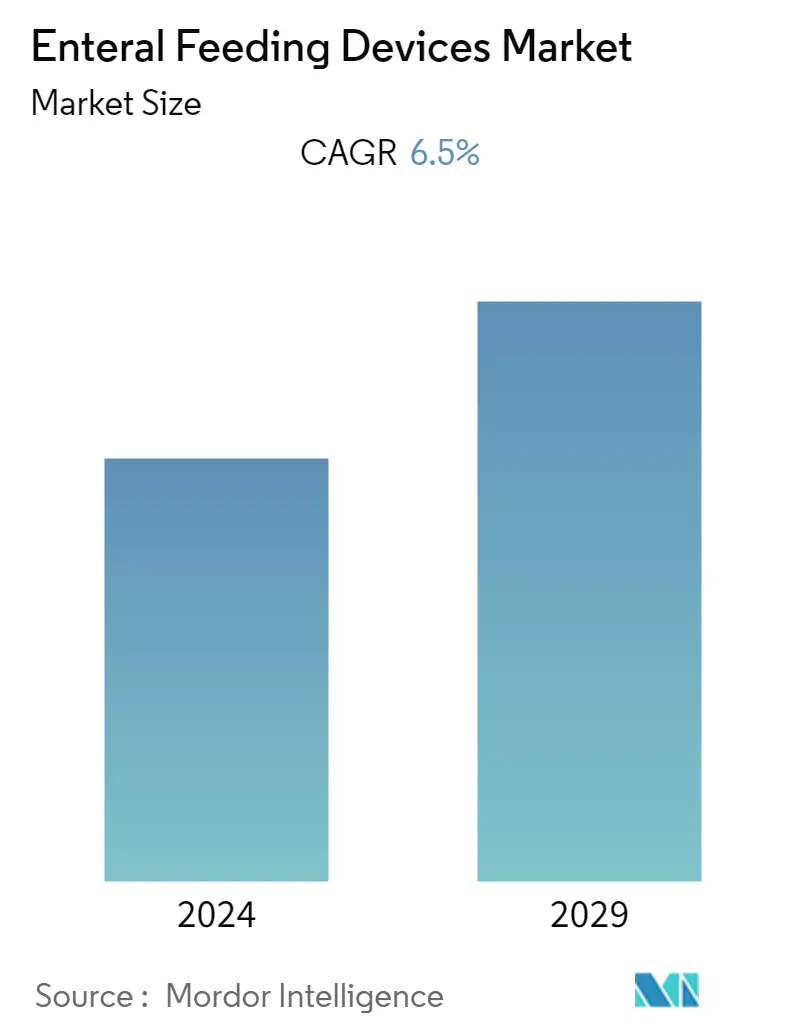
| Study Period | 2019 - 2029 |
| Base Year For Estimation | 2023 |
| CAGR | 6.50 % |
| Fastest Growing Market | Asia-Pacific |
| Largest Market | North America |
| Market Concentration | Low |
Major Players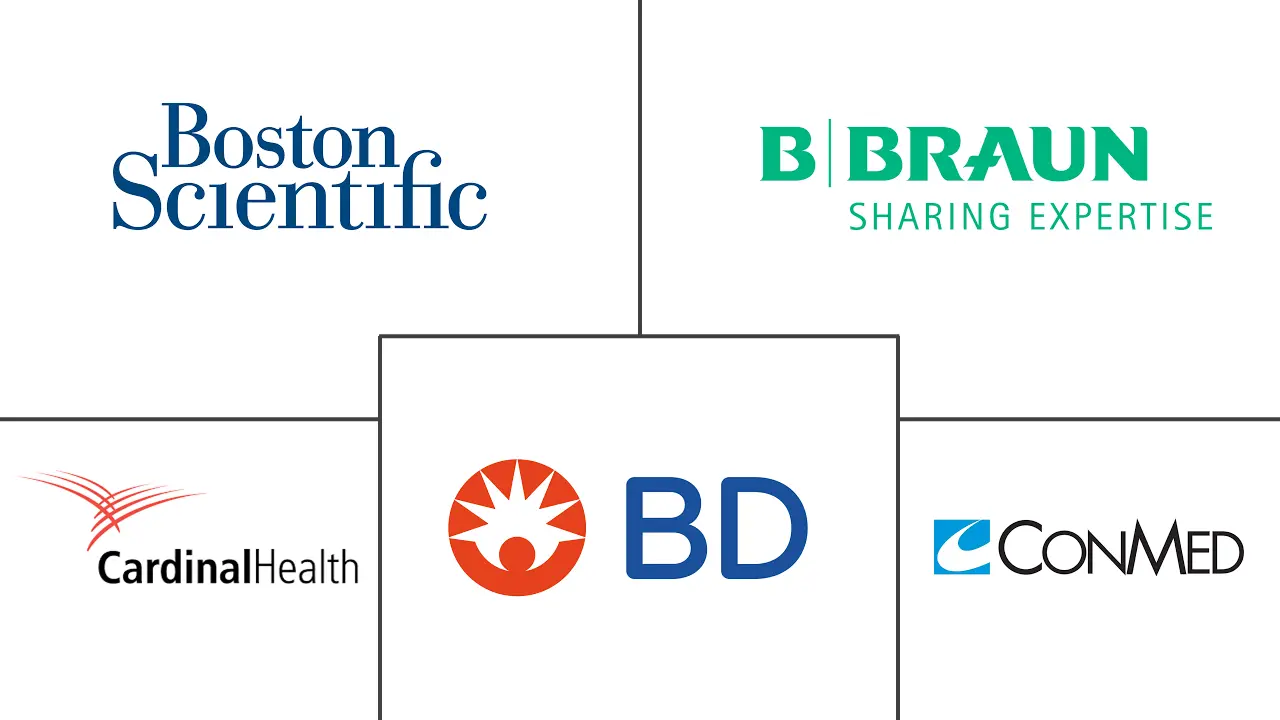
*Disclaimer: Major Players sorted in no particular order |
Enteral Feeding Devices Market Analysis
The enteral feeding devices market registered a CAGR of 6.50% over the forecast period.
The COVID-19 pandemic significantly impacted the enteral feeding devices market. Due to the disturbance of the normal intestinal mucosa, patients with COVID-19 who were extremely unwell had reduced nutrient absorption. For instance, according to a research article published by the National Library of Medicine in March 2022, patients had considerable levels of inflammation, stress, and catabolism, as well as a marked rise in their need for protein and calories. Immediate enteral nutrition support and the provision of sufficient nutrients were essential to prevent malnutrition in these patients. According to guidelines by the European Society for Clinical Nutrition and Metabolism (ESPEN) on nutrition in the ICU, gastric enteral nutrition was advised for severe COVID-19 patients. It should preferably be performed using a pump with a flow regulator within 48 hours of admission to the ICU. Hence, the COVID-19 pandemic increased the need for enteral feeding devices, especially for those in intensive care units. Hence, the market is expected to have stable growth over the forecast period.
The factors responsible for the market's growth include the growing geriatric population and age-related chronic diseases, the increasing number of premature births, and the growing demand for enteral feeding in home care settings. For instance, according to the Center for Disease Control (CDC) update on Preterm birth, in November 2022, preterm birth affected about 1 of every 10 infants born in the United States in 2021. The preterm birth rate rose 4% in 2021. The rate of preterm birth among African-American women (14.8%) was about 50% higher than the rate of preterm birth among white or Hispanic women (9.5% and 10.2% respectively) in 2021. Since preterm birth is frequently associated with the progressive development of malnutrition, these statistics indicate that the demand for enteral feeding devices is anticipated to increase over the coming years.
Additionally, various initiatives taken by the key market players, such as product launches, mergers, acquisitions, and partnerships, are expected to boost the market's growth during the forecast period. For instance, in September 2021, Vonco Products LLC reported that the patented EnteraLoc Flow direct-connect enteral nutritional delivery system was granted 510(k) clearance by the U.S. Food and Drug Administration (FDA). Such product clearance is expected to significantly impact the market, thereby driving the market's growth.
The above-mentioned factors, such as the growing geriatric population and age-related chronic diseases, the increasing number of premature births, and the growing demand for enteral feeding in home care settings, are expected to drive the enteral feeding device market growth across the world. However, complications associated with enteral feeding tubes and healthcare reimbursement issues are the major factors restraining the market's growth.
Enteral Feeding Devices Market Trends
Diabetes Segment Is Expected to Witness Significant Growth Over the Forecast Period
Enteral nutrition in people with diabetes has certain specificities that arise from the risk of hyperglycemia, ketoacidosis, hypoglycemia, and a fast shift to catabolism upon starvation. The diabetes segment is expected to witness substantial growth during the forecast period attributed to factors such as the increasing burden of diabetes and the growing implementation of strategic initiatives by market players.
As per a 2021 update by the International Diabetes Federation (IDF), approximately 537 million adults (20-79 years) had diabetes in 2021. The same source also reported that the total number of people living with diabetes is projected to rise to 643 million by 2030 and 783 million by 2045. Enteral nutrition plays an important role in reducing the risk of malnutrition in diabetic patients by providing the necessary macro and micronutrients, such as energy, protein, vitamins, and minerals. Thus, the demand for enteral feeding devices will likely increase among the diabetic patient population shortly.
Furthermore, according to an article published by Reviews in Endocrine and Metabolic Disorders in March 2022, the management of patients with diabetes/hyperglycemia is challenging and requires a specific nutritional approach, the purpose of which is to fulfill the nutritional requirements while maintaining optimal glycemic control. This nutritional requirement can be fulfilled by enteral nutrition feeding. Thus, increasing nutritional requirements is expected to increase the demand for enteral feeding devices, thereby driving market growth.
Thus, the factors above, such as the increasing burden of diabetes coupled with increased nutritional requirements, are anticipated to boost the segment's growth throughout the analysis period.
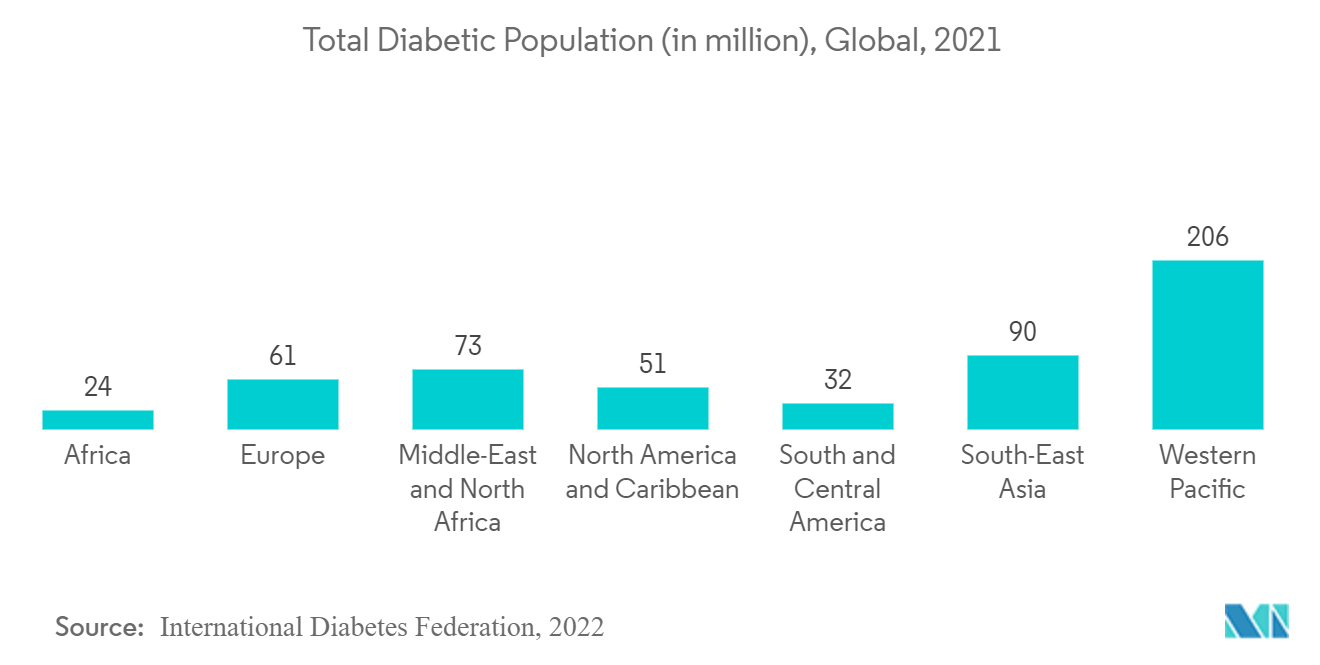
North America Expected to Hold a Significant Growth in the Enteral Feeding Devices Market Over The Forecast Period
The North American region is expected to hold a significant share in the enteral feeding devices market over the forecast period due to factors such as an increase in the burden of chronic diseases and surgical procedures. For instance, as per statistics by the International Diabetes Federation (IDF) Diabetes Atlas, 10th Edition, in 2021, 1 in 7 adults (51 million) are living with diabetes in North America. The number of adults with diabetes is expected to reach 57 million by 2030 and 63 million by 2045 in North America. Patients with diabetes are likely to have a threefold higher risk of being hospitalized. Many consequences of improperly managed diabetes, such as stroke, can necessitate enteral feeding. Likewise, as per the data published by the Canadian Cancer Society, in 2022, it was estimated that around 4,100 Canadians would be diagnosed with stomach cancer. Thus, such statistics indicate that the demand for enteral feeding devices for nutrition management within the country will increase over the coming years, ultimately boosting the market growth.
Moreover, market players are engaged in various strategies contributing to market growth. For instance, in May 2021, QMD reported the addition of Nasogastric Tubes to its Degania Enteral Feeding Product Portfolio. Nasogastric tubes are manufactured from premium materials and designed to comply with ENFit connection standards for improved patient safety. Likewise, in September 2021, Vonco Products' EnteraLoc Flow direct-connect enteral nutritional delivery system received 510 (K) clearance from the United States Food and Drug Administration (USFDA). The system, which features a pouch with a leak-proof seal, Vonco's direct-connect ENFit device, and a tube for food delivery, can deliver nutrition in a hospital or home care setting and can be tailored to meet most dietary requirements.
Thus, the market is expected to witness significant growth over the forecast period due to the above-mentioned factors, such as an increase in the burden of chronic diseases and surgical procedures.
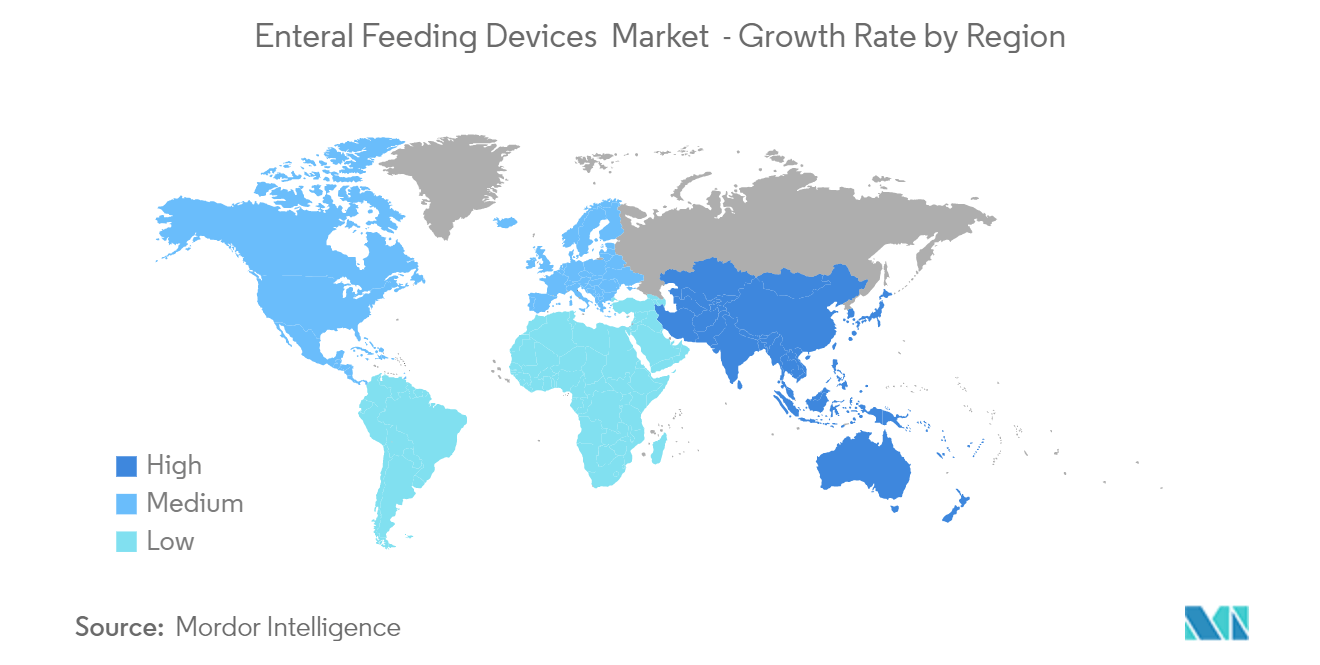
Enteral Feeding Devices Industry Overview
The enteral feeding devices market is fragmented in nature due to the presence of several companies operating globally and regionally. The companies in the market include B. Braun Melsungen AG, Boston Scientific Corporation, Conmed Corporation, Cardinal Health, and Becton Dickinson and Company, among others.
Enteral Feeding Devices Market Leaders
-
B. Braun Melsungen AG
-
Boston Scientific Corporation
-
Conmed Corporation
-
Cardinal Health, Inc.
-
Becton, Dickinson and Company
*Disclaimer: Major Players sorted in no particular order
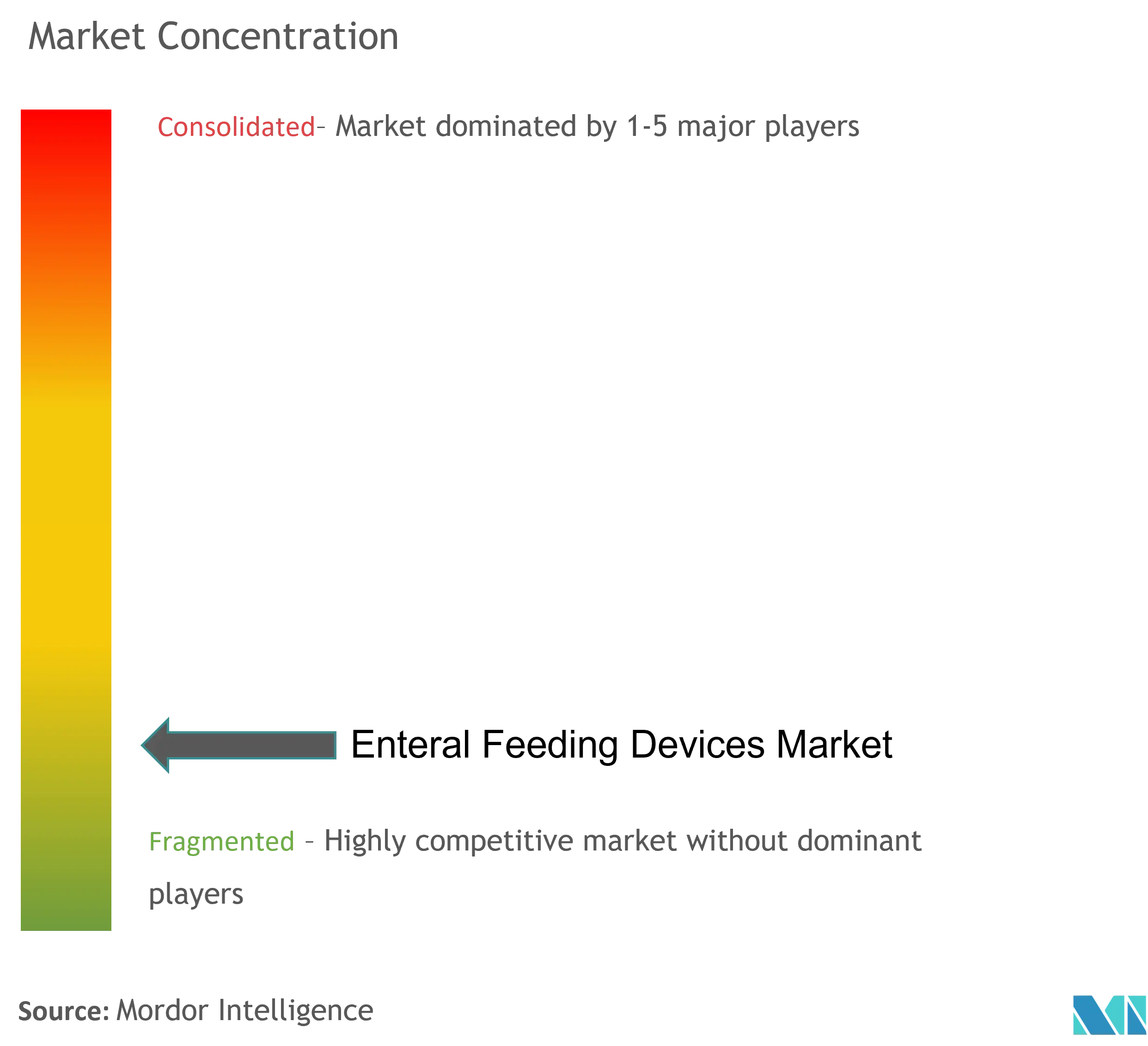
Enteral Feeding Devices Market News
- April 2022: Fresenius Kabi launched a new enteral nutrition product app. The Enteral Nutrition Product App makes accessing detailed product information easier and includes a quick comparison tool to compare nutritional values against reference nutrient intakes.
- March 2022: Vygon acquired Macatt Medica to boost the presence of Vygon in the South American region, specifically for its wide range of enteral feeding products.
Enteral Feeding Devices Market Report - Table of Contents
1. INTRODUCTION
- 1.1 Study Assumptions and Market Definition
- 1.2 Scope of the Study
2. RESEARCH METHODOLOGY
3. EXECUTIVE SUMMARY
4. MARKET DYNAMICS
- 4.1 Market Overview
-
4.2 Market Drivers
- 4.2.1 Growing Geriatric Population and Age Related Chronic Diseases
- 4.2.2 Increasing Number of Premature Births
- 4.2.3 Growing Demand for Enteral Feeding in Home Care Settings
-
4.3 Market Restraints
- 4.3.1 Complications Associated with Enteral Feeding Tubes
- 4.3.2 Healthcare Reimbursement Issues
-
4.4 Porter's Five Forces Analysis
- 4.4.1 Threat of New Entrants
- 4.4.2 Bargaining Power of Buyers/Consumers
- 4.4.3 Bargaining Power of Suppliers
- 4.4.4 Threat of Substitute Products
- 4.4.5 Intensity of Competitive Rivalry
5. MARKET SEGMENTATION (Market Size by Value- USD million)
-
5.1 By Product Type
- 5.1.1 Enteral Feeding Pumps
- 5.1.2 Enteral Feeding Tubes
- 5.1.3 Other Product Types
-
5.2 By Age Group
- 5.2.1 Adults
- 5.2.2 Pediatrics
-
5.3 By End User
- 5.3.1 Hospitals
- 5.3.2 Ambulatory Care Services
- 5.3.3 Other End Users
-
5.4 By Application
- 5.4.1 Oncology
- 5.4.2 Neurology
- 5.4.3 Critical Care
- 5.4.4 Diabetes
- 5.4.5 Gastroenterology
- 5.4.6 Other Applications
-
5.5 Geography
- 5.5.1 North America
- 5.5.1.1 United States
- 5.5.1.2 Canada
- 5.5.1.3 Mexico
- 5.5.2 Europe
- 5.5.2.1 Germany
- 5.5.2.2 United Kingdom
- 5.5.2.3 France
- 5.5.2.4 Italy
- 5.5.2.5 Spain
- 5.5.2.6 Rest of Europe
- 5.5.3 Asia-Pacific
- 5.5.3.1 China
- 5.5.3.2 Japan
- 5.5.3.3 India
- 5.5.3.4 Australia
- 5.5.3.5 South Korea
- 5.5.3.6 Rest of Asia-Pacific
- 5.5.4 Middle East and Africa
- 5.5.4.1 GCC
- 5.5.4.2 South Africa
- 5.5.4.3 Rest of Middle East and Africa
- 5.5.5 South America
- 5.5.5.1 Brazil
- 5.5.5.2 Argentina
- 5.5.5.3 Rest of South America
6. COMPETITIVE LANDSCAPE
-
6.1 Company Profiles
- 6.1.1 Abbott Laboratories
- 6.1.2 B. Braun Melsungen AG
- 6.1.3 Boston Scientific Corporation
- 6.1.4 Conmed Corporation
- 6.1.5 Cook Medical Inc.
- 6.1.6 Fresenius SE & Co. KGaA
- 6.1.7 Halyard Health Inc.
- 6.1.8 Nestle SA
- 6.1.9 Avanos Medical Inc.
- 6.1.10 Cardinal Health Inc.
- 6.1.11 Becton Dickinson and Company
- 6.1.12 Vygon SA
- 6.1.13 Applied Medical Technology Inc.
- 6.1.14 Amsino International Inc.
- 6.1.15 Fidmi Medical
- 6.1.16 ALCOR Scientific Inc.
- *List Not Exhaustive
7. MARKET OPPORTUNITIES AND FUTURE TRENDS
** Subject To AvailablityEnteral Feeding Devices Industry Segmentation
As per the scope of the report, enteral feeding refers to the delivery of a nutritionally complete feed containing protein, carbohydrates, fat, water, minerals, and vitamins directly into the stomach, duodenum, or jejunum through devices such as tubes and pumps. It is used for people who have a functional gastrointestinal tract but are unable to consume foods orally to meet their nutrient requirements. The enteral feeding devices market is segmented by product type (enteral feeding pumps, enteral feeding tubes, and other product types), age group (adults and pediatrics), end user (hospitals, ambulatory care services, and other end users), application (oncology, neurology, critical care, diabetes, gastroenterology, and other applications), and geography (North America, Europe, Asia-Pacific, Middle East and Africa, and South America). The report also covers the estimated market sizes and trends for 17 countries across major regions globally. The report offers the value (in USD) for the above segments.
| By Product Type | Enteral Feeding Pumps | |
| Enteral Feeding Tubes | ||
| Other Product Types | ||
| By Age Group | Adults | |
| Pediatrics | ||
| By End User | Hospitals | |
| Ambulatory Care Services | ||
| Other End Users | ||
| By Application | Oncology | |
| Neurology | ||
| Critical Care | ||
| Diabetes | ||
| Gastroenterology | ||
| Other Applications | ||
| Geography | North America | United States |
| Canada | ||
| Mexico | ||
| Geography | Europe | Germany |
| United Kingdom | ||
| France | ||
| Italy | ||
| Spain | ||
| Rest of Europe | ||
| Geography | Asia-Pacific | China |
| Japan | ||
| India | ||
| Australia | ||
| South Korea | ||
| Rest of Asia-Pacific | ||
| Geography | Middle East and Africa | GCC |
| South Africa | ||
| Rest of Middle East and Africa | ||
| Geography | South America | Brazil |
| Argentina | ||
| Rest of South America |
Enteral Feeding Devices Market Research FAQs
What is the current Enteral Feeding Devices Market size?
The Enteral Feeding Devices Market is projected to register a CAGR of 6.5% during the forecast period (2024-2029)
Who are the key players in Enteral Feeding Devices Market?
B. Braun Melsungen AG, Boston Scientific Corporation, Conmed Corporation, Cardinal Health, Inc. and Becton, Dickinson and Company are the major companies operating in the Enteral Feeding Devices Market.
Which is the fastest growing region in Enteral Feeding Devices Market?
Asia-Pacific is estimated to grow at the highest CAGR over the forecast period (2024-2029).
Which region has the biggest share in Enteral Feeding Devices Market?
In 2024, the North America accounts for the largest market share in Enteral Feeding Devices Market.
What years does this Enteral Feeding Devices Market cover?
The report covers the Enteral Feeding Devices Market historical market size for years: 2019, 2020, 2021, 2022 and 2023. The report also forecasts the Enteral Feeding Devices Market size for years: 2024, 2025, 2026, 2027, 2028 and 2029.
Enteral Feeding Devices Industry Report
The enteral feeding devices market is segmented by product type, age group, end user, application, and geography. The industry analysis includes enteral feeding pumps, enteral feeding tubes, and other product types. The market forecast provides insights into the value for adults and pediatrics, with end users including hospitals, ambulatory care services, and other end users. The market segmentation covers applications in oncology, neurology, critical care, diabetes, gastroenterology, and other applications. The market outlook spans North America, Europe, Asia-Pacific, the Middle East and Africa, and South America.
The market size and market growth are critical aspects of the industry reports. The industry outlook indicates a robust market forecast with a detailed market overview. This industry research emphasizes the significance of market data and market value in understanding the industry trends. Market leaders play a significant role in shaping the market predictions and market review.
The industry statistics and industry information provide a comprehensive view of the market segmentation. The report example and report pdf offer a detailed market analysis and industry sales overview. The industry size and growth rate are essential metrics in the industry research, highlighting the market's potential.
Market trends and market outlook are crucial for understanding the future direction of the enteral feeding devices market. The research companies and market leaders contribute to the market predictions and market review. The industry reports and industry statistics offer valuable insights into the market data and industry trends, ensuring a thorough understanding of the market value and market forecast.
In conclusion, the enteral feeding devices market report provides an extensive industry overview, market analysis, and market segmentation. The market outlook and market forecast are supported by detailed industry research and industry information, ensuring a comprehensive understanding of the market's growth rate and industry size. The report pdf serves as a valuable resource for industry sales and market predictions, offering a complete market review and insights into the market's future direction.



